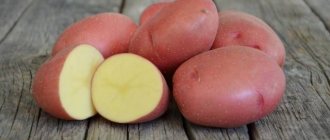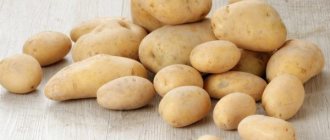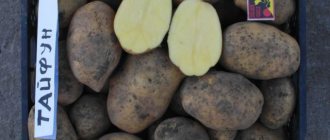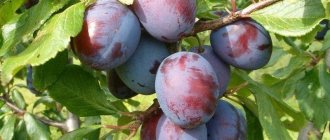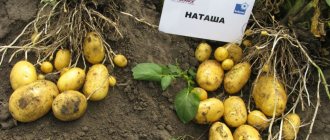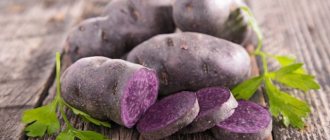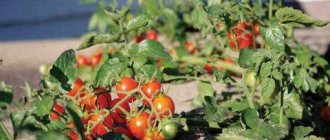Vegetable growing » Potatoes
0
2286
Article rating
Kira Stoletova
Alena potatoes have gained great recognition in the world market due to the fact that they can produce a good harvest, even in areas with short summers and unfavorable soil. The development of bushes occurs at a decent speed, literally in a month and a half. During this time, the fruits fully ripen and accumulate the required amount of necessary elements.
Description of Alena's potatoes
Description of the variety, its origin and development
The variety is of Dutch origin; breeders developed it at the end of the last century. Within a few years he was included in the national registry. It became widespread in Russia thanks to specialists from the Siberian Scientific Research Institute of Agriculture in Omsk.
It is believed that Alena is suitable for cultivation in countries with harsh climates. The variety is well suited for industrial and home cultivation. Potatoes are very unpretentious, so they are recommended for planting in Siberia, the Urals and the Far East. Potatoes can withstand long-term storage well and are also well transported over long distances.
Neat potatoes of the Alena variety
Alena belongs to the early varieties. Tubers ripen in one and a half months.
For reference! The yield reaches 15-20 tons per hectare, and under favorable conditions it rises to 30-40 tons.
The bushes are short in length and spreading in width. The leaves are slightly wavy and rich green in color. The crop blooms profusely with red-violet buds, but there are almost no berries. The root system is very branched; under good conditions, up to 10-12 tubers can be collected from one bush.
The variety is slightly susceptible to diseases. Potatoes do not degenerate, so you can safely leave the seeds for later planting.
The tubers are large, weighing up to 100 - 150 g, the shape of the potatoes is oval and even. The tubers are identical in shape and size, so they have a marketable appearance and sell well.
The peel is pink, very thin, the flesh is creamy or yellowish. Starch content 14%. This is a good indicator. Can be used for making soups, purees, baking and other dishes. On an industrial scale it is suitable for preparing starch and chips.
Potatoes of the Alena variety, as a rule, have a pleasant presentation
Video about the variety “Alena”
Unfortunately, there is no video for this variety at the moment. We invite you to watch the video section of our website, where other videos about potatoes and other agricultural crops are posted. We and the entire farming community will be grateful if you send us your video or link about this variety from YouTube or any other video hosting service. If you see this message, it means that we have not yet been able to find a suitable video for this variety.
Similar articles:
Potatoes and all their varieties in detail here → Potato variety “Bryansk New” - description characteristics reviews photos video
Potatoes and all their varieties in detail here → Potato variety “Bonnie” - description characteristics reviews photos video
Potatoes and all their varieties in detail here → Potato variety “Borus” - description characteristics reviews photos video
Potatoes and all their varieties in detail here → Potato variety “Bellarose” - description characteristics reviews photos video
Potatoes and all their varieties in detail here → Potato variety “Bashkir” - description characteristics reviews photos video
Advantages disadvantages
From the description above, one can already note the main advantages of the variety. There are many more of them than there are minuses.
Advantages:
- excellent taste;
- high productivity;
- storage rates are high;
- withstands transportation well;
- can grow on any soil;
- the variety is drought-resistant;
- potatoes are slightly susceptible to diseases;
- adapts to adverse weather conditions.
There are no obvious deficiencies in the variety. But to get a really good harvest, you will have to carefully study the cultivation technology and adhere to agricultural techniques.
Botanical description
Alvara is one of the best varieties not only in terms of yield, but also in terms of external and taste characteristics. Its bushes may not be very different from other varieties, but the roots are very recognizable.
Root crops
In one nest you can find 8-14 beautifully aligned potatoes.
Familiarize yourself with the description and structure of a potato tuber.
Characteristics of tubers:
- oval shape, elongated;
- weight - 90–110 g;
- peel color - red-pink;
- the surface is smooth, the eyes are small, few in number and shallow;
- the pulp is light yellow or creamy in cross section, does not darken when peeled and cooked, the ability to boil is average;
- starch content - 12.8–14.1%;
- universal application, in industry it is used for the production of chips and semi-finished products;
- taste rating: 4.8 (5-point system).
Description of the tops
Alvara bushes grow high - up to 80 cm. The stems are erect and semi-erect, the type is intermediate. The foliage is dense and green. The leaves are medium-sized with slightly wavy edges, the surface is smooth. During the flowering period, each bush forms several inflorescences of small purple flowers.
Did you know? In 1995, astronauts grew the first vegetable aboard a spacecraft. It was potatoes.
Rules for caring for the variety
While the potatoes are ripening, weeding and hilling must be carried out regularly. In dry years, drip irrigation can be used to moisten the soil and retain moisture. To retard the growth of weeds, dry grass or straw can be laid between the rows.
Hilling scheme
Recommendations for hilling
Hilling is carried out when the height of the bushes reaches 10 cm. After two weeks, the procedure can be repeated.
Before hilling, the area is weeded and moistened. Moisture is especially needed during the period of bud formation and flowering: at this moment, tubers form. If there is insufficient moisture, the potatoes will be small and will bring only disappointment when harvesting.
Advice ! A few days before harvesting, you need to feed the bushes with phosphates. This allows the tuber to absorb the necessary elements from the tops.
Growing
Tubers are planted after the soil has warmed to +8 degrees. In the southern regions, planting time occurs at the beginning of April, in the middle zone it is the end of April or the first week of May. In the Urals and Siberia, potato tubers are planted in the middle or at the end of May. It should be borne in mind that the culture does not tolerate negative temperatures.
Choose an open, sunny space without flooding and surface groundwater. Good predecessors for potatoes are peas, phacelia, white mustard, zucchini, cucumbers, beets, and garlic. Before planting, the area is dug up with a bayonet and weeds are removed.
How to harvest
The ripening of potatoes is signaled by yellowed tops. If this happens, it means it's time to harvest. As a rule, the tops fall off in August or September, depending on the planting time. Before harvesting potatoes, the tops need to be mowed 10-15 days before digging begins.
Harvested potatoes in heaps
The work order is as follows:
- The tubers are dug up with a shovel or passed between the rows with a walk-behind tractor.
- After this, they should lie in the sun for two to three hours to dry in order to avoid rotting. It is desirable that the weather be dry.
- The final stage will be collecting root crops in bags or nets.
- The containers are moved to storage areas.
Harvest and storage
You can determine that the potatoes are ripe by the autumn withering of the above-ground parts. 2 days before the expected collection of the product, the tops are mowed or cut off. Tubers are harvested in dry, clear weather. Use a pitchfork or shovel to carefully dig up the bush from the ridge side, shake off the soil and leave the tubers to dry for 2–3 hours. Before storing the vegetables, they are sorted, removing damaged and diseased specimens. Place the crop in a dry, well-ventilated room with a temperature of +2...+4°C and a relative humidity of 80% - 90%.
Vegetables can be stored using one of the options:
- in boxes - tubers are placed in containers that are placed on pallets or boards (distance from the floor - at least 10 cm);
- in bulk - the layer of potatoes should not exceed 1.5 m;
- in nets, fabric bags - in stacks, no more than 1.5 m high.
Seed material should be stored separately from the general purpose product.
During the winter period, it is necessary to regularly inspect the tubers, removing rotten and diseased ones. If all recommendations are followed, the shelf life of this product will be 95%. Alena potatoes are unpretentious when cultivated - they do not require special costs or effort. With such small shortcomings that are lost against the backdrop of a huge number of positive criteria, this variety of nightshade plant is undoubtedly worthy of taking pride of place in your garden bed. By following the necessary recommendations for agricultural cultivation techniques, taking care and proper care of the plant, you will certainly get the expected result: a high, excellent harvest of your favorite vegetable.
Planting and growing seed potatoes
After the choice has been made in favor of one variety or another, another difficult task remains - to grow a good harvest from seed potatoes. The ideal planting material would be tubers weighing up to 80 grams. If the tubers turn out to be larger, then during cultivation you will have to use a lot of fertilizers. Buying seed potatoes is not cheap, so summer residents try to breed their own planting material and also share it with each other.
For planting potatoes, select fertile and loose soil. Planting work is carried out in early May.
Some gardeners tend to think that if they plant potatoes earlier, they will ripen sooner. But in reality this is far from happening, so there is no need to rush. We must wait for the onset of stable heat. But it is advisable to prepare the beds in the fall by adding compost and humus to them. Holes are dug to a depth of 30 cm. For small bushes, the distance between holes is left up to 25 cm, and for tall bushes - up to 40 cm. Up to half a meter is left between rows.
With the appearance of the first shoots, the plantings begin to be irrigated. Do this 1-2 times a week. They try to prevent water from getting into the leaf area. After each watering, the soil in the beds is loosened, simultaneously removing weeds. To prevent the soil from evaporating excess moisture and weeds from bothering you, mulching is carried out. For this purpose, use hay, sawdust or pine needles. It is recommended to carry out timely prevention of certain diseases and fight pests using special-purpose drugs.
The main pest of potatoes is the Colorado potato beetle.
At the moment, many means have been developed to combat it, which are used both during planting of tubers and during the growth process. Breeders also constantly introduce something new and offer gardeners varieties that are resistant to the negative effects of this insect. Despite this, the problem remains relevant, and most summer residents solve it the old fashioned way: they spray the plantings with a preparation against the Colorado potato beetle several times a season.
Different varieties of seed potatoes have their own advantages and disadvantages. To compensate for them, it is advisable to plant several varieties in the beds, the descriptions of which are fundamentally different. Not only the external and taste characteristics can be different, but also the ripening period, requirements for care, and disease resistance. This will allow you to compare varieties from personal experience and choose the best one specifically for your needs.
